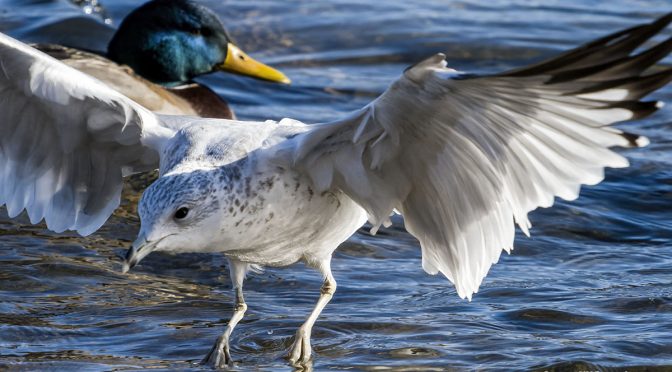This article discusses a gulls in flight challenge that I gave myself, and shares some images I captured during this practice exercise.
Like many photographers, I haven’t been going out with my camera nearly as often as I would like. With COVID-19 safety precautions in place, I’ve been avoiding many of my favourite indoor photography locations. Yesterday I created a couple of practice exercises, one of which was a gulls in flight challenge.
NOTE: Click on images to enlarge.

Rather than simply pan with unobstructed birds-in-flight, I wanted to make my gulls in flight challenge a bit tougher. I decided I would specifically try to photograph gulls in three different scenarios. The first was to photograph birds coming into land amongst other birds… as you can see in the image above and the two immediately below.


The second scenario was to photograph gulls that were landing or flying quite close to my physical location. The next seven images are of this type.







The third scenario in my gulls in flight challenge, was to photograph birds that were flying almost directly at me. This part of the challenge was to see how my E-M1X would perform in terms of continuous auto focus. The final six images in this article fit into this third scenario.

Just to keep things interesting, I limited myself to using the Olympus Cluster Area continuous auto-focusing mode. I shot in Manual, Auto-ISO, using silent shutter at 18 frames-per-second.

In order to get a reasonably low shooting angle I sat on some rocks that were close to the shoreline.

Setting some specific parameters for my gulls in flight challenge made the exercise much more beneficial. It forced me to push my handheld skills, as well as the capabilities of my E-M1X.

It also helped me learn more about using the Olympus Cluster Area continuous auto-focusing mode in various scenarios.
Technical Note
Photographs were captured hand-held using camera gear as noted in the EXIF data. Images were produced from RAW files using my standard process.

How you can help keep this site advertising free
My intent is to keep this photography blog advertising free. If you enjoyed this article and/or my website and would like to support my work, you can purchase an eBook, or make a modest $10 donation through PayPal. Both are most appreciated. You can use the Donate button below. Larger donations can be made to tom@tomstirr.com through PayPal.

Word of mouth is the best form of endorsement. If you like our website please let your friends and associates know about our work. Linking to this site or to specific articles is allowed with proper acknowledgement. Reproducing articles, or any of the images contained in them, on another website or in any social media posting is a Copyright infringement.
Article and images are Copyright 2020 Thomas Stirr. All rights reserved. No use, duplication or adaptation of any kind is allowed without written consent. If you see this article reproduced anywhere else it is an unauthorized and illegal use. Posting comments on offending websites and calling out individuals who steal intellectual property is always appreciated!


Great captures Tom! I’ve been playing with the C-AF Cluster as well since you mentioned it a while ago.
I haven’t located a group of co-operative gulls (or much else) like you seem to have. I have had some ducks, but not in as good light.
I’ve had some joy, not as much as you have as displayed here.
You say you are shooting manual, have you tried Auto ISO with manual? Or even Shutter priority with Auto ISO?
Hi Jim,
When photographing birds I always use Manual with Auto-ISO. I have updated the article to mention this in the body of the piece.
Tom
Forget about head and shoulders above my gull shots, it’s more like pedestal height above. Great shots! I was wondering how many frames were shot during this particular exercise?
Hi Lewsh,
A typical practice exercise is dependent on my available time, subject matter, and frame rate used. Sometimes I capture several hundred images to well over a thousand. In this case it was several thousand. I spent quite a bit of my time experimenting with the Olympus Cluster Area C-AF specifically with gulls flying into groups of other birds and landing among them. I also did a lot of practice with Cluster Area C-AF capturing images with an approaching gull flying in very close proximity to me. As you can imagine both of these scenarios are quite challenging for both a photographer and their gear’s auto-focusing system.
It is important to note that my objective when doing a practice exercise like this is not to capture a high ratio of usable photographs. It is actually the exact opposite… my goal is to regularly fail with my image captures. I want to push my skills and my gear to find out when I miss capturing photographs. Then, I continue the practice exercise to work on my technique to see if I can overcome my failures. This is the only way that I can establish my current photographic limits so I can put in the work necessary to improve.
Tom
I think you meant MC-20, not MC-30 for the teleconverter.
Hi Reno,
Thank you very much for catching my typo in the EXIF data… it was compounded when I copied and pasted for successive images. I have corrected all of the images.
Tom